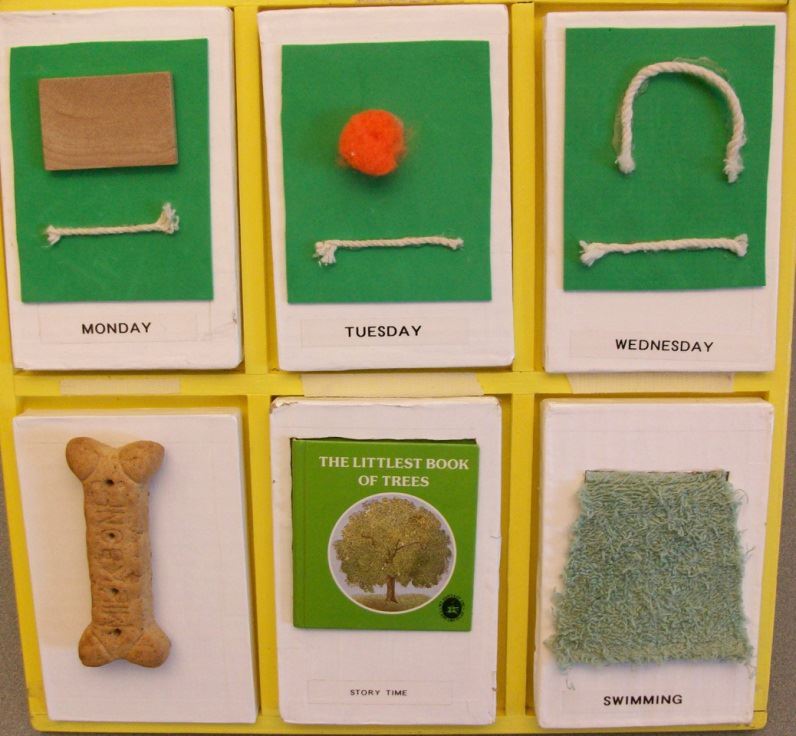
Monthly Tactile Calendars
Tactile calendars can be used to help students who are blind or deafblind to learn about the passage of time.
There are many ways to create tactile calendars for children who are blind or deafblind, and Cindy O’Connell shares her ideas on making Individualized Tactile Calendars. She explains how to select symbols to represent each day of the week and to arrange them in a sequence to help students to understand the passage of time each month.
Now that your schedule is in place for the coming school year (and your tangible timeline is set up!) focus on using the structure you have established to create individualized, adapted calendars. Traditional braille calendars may be useful as a means of introducing time-related vocabulary, but the required spatial concepts and reading skills are often too advanced for entry-level students and can be meaningless for students who are not braille readers. It is much more meaningful for students with visual and multiple impairments to break the concept of a month down into its components, using simple, meaningful language with concrete supports.
Setting Up the Schedule
When you set up your classroom schedule at the beginning of the year, be mindful that you will want to use the routines you establish (along with clinical services and outside classes) to help students distinguish one day from another. Represent each day with a tangible symbol, or a Mayer-Johnson picture representative of an activity or class that is specific to that day. For instance, if Monday is the day you have cooking, use a small spoon, part of a spoon, or a picture of a spoon to represent cooking. If Tuesday is the day you go on a field trip, find a tangible symbol, or a MayerJohnson picture to signify that it is the day you go on a field trip (e.g., a piece of slate if you typically walk, a key if you drive). Finding suitable symbols to represent weekends is always a challenge. I used miniature etch-a-sketches that I found online as a symbol for common things students might do at home on a weekend (the shape and smooth surface were loosely representative of a TV screen, CD player, or radio). Have fun and be resourceful when choosing a symbol to represent weekends and vacations for your own students.
Representing Changes in the Routine
Represent changes to your daily routine (e.g., holidays, vacations, assemblies, hearing tests, and Doctor’s appointments) with related objects or pictures on the calendar. Maintain regular communication with families so that you can incorporate special events that happen at home too, e.g., grandparents visiting (use a picture of the grandparents, or a voice output device with a recording of their voices), a sibling leaving for college (you can get miniature duffle bags on-line!), and after school activities. Many students with visual and multiple impairments become anxious over change to their routine. Tangible calendars can help to minimize this anxiety by preparing students for upcoming disruptions to their normal routines and demonstrating that their regular routine will resume when the change is over.
Time Concepts
Frequently it’s assumed that a student has adequate time concepts because they are able to rotely recite the days of the week and the months of the year, when what they are actually demonstrating is simply a rotely learned skill, not comprehensive knowledge. Determine developmental levels by performing an informal assessment, such as the Texas School for the Blind Assessment, which presents a clear breakdown of math concepts, and contains a quick and easy section on time. Testing pinpoints gaps with basic time concepts that aren’t readily apparent and these gaps tell you where to start teaching. Testing may show that there is a gap in understanding the concept of yesterday/today/tomorrow. If this is the case, isolate the concepts by designing a tangible calendar focusing just on yesterday/today/tomorrow. It’s easy to do. Simply present what the student did yesterday, what they are doing today, and what they will do tomorrow using MayerJohnson pictures, or tangible symbols.
Perhaps the gap is with how days go together to make a week. This means you want to make a tangible calendar presenting a single week. The assessment might show a gap with the concepts of last week/this week/next week. If so, design a tangible calendar to isolate those concepts. Make a board with three rows, one for last week, one for this week and one for next week. Be sure to update it weekly, or you will have very confused students on Monday mornings! When your student is ready for an entire month, make a tangible calendar to represent the whole month (down-size tangible symbols by using remnants of activities).
Tactile Symbols
At Perkins, we use uniform tactile symbols with different textured patterns (designed by our speech department) to represent days of the week. If you use tactile symbols to designate days of the week (this is optional), position them above the tangible symbols representing studentspecific routines. Start up at the top, with the day of the week, systematically moving down to the tangible symbol representing the day’s theme. Narrate as you explore the calendar, e.g., “Yesterday was Monday, we made dog treats.” “Today is Tuesday, Kevin will come and read us a story.” “Tomorrow is Wednesday, we will go swimming.” Provide as much hand-under hand assistance as necessary and remember to label spatial concepts as you explore, e.g., “Let’s start at the top of the calendar to see what day yesterday was.”
Have fun with your adapted calendars!
